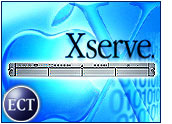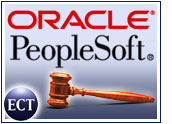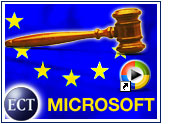
Apple Computer is used to name-calling. Macs have been dismissed as geek machines, used by members of a cult-like community who appreciate design over function and an eye-candy interface over simpler, more humble graphics.
However, that image has slowly begun to fade. Now, Apple is going after its toughest audience yet: IT managers.
This is not the first time Apple has tried to crack the corporate market, but in this round, the company has eschewed splashy, dramatic efforts. It is focusing instead on quietly gaining respect among Windows-centric customers.
The company’s not-so-secret weapon is Xserve, a powerful and inexpensive server that could land on IT wish lists — if Apple plays its cards right.
Fresh Fruit
Recently, Apple announced a new advertising and marketing strategy designed to lure consumers away from Windows. Heavily dependent on footage of “real people” wrinkling their noses with disgust at using Wintel-based machines, the ads could spark more interest in Apple’s consumer line.
But the company is taking a more low-key approach to targeting corporate users, hoping that the technology speaks for itself.
“We want to be humble going in,” Alex Grossman, Apple’s director of server and storage hardware, told the E-Commerce Times. “We think we’re going to have the best system going, but we want to make sure we position this correctly.”
Although the company is cagey about its marketing strategy, it is eager to boast about its product.
The Xserve possesses nice specs: The top-of-the-line model comes with dual 1 GHz G4 processors, 2 MB DDR L3 cache per chip, 480 GB storage capacity and a Unix-based server operating system, all in a rack-mounted machine that looks vaguely like a control panel from the movie “2001: A Space Odyssey.”
Take My Server, Please
The most compelling number for IT departments could be the Xserve’s price tag. At US$2,999, the server is competitively priced, and it comes with a cost-savings kicker: an unlimited client license.
Other servers charge per user, which means companies often end up paying more for licensing than for hardware.
Tom Goguen, Apple’s director of server software, told the E-Commerce Times that such an arrangement could make a big difference in IT managers’ minds. Also, he said, managers might be swayed simply by being around Macs in the enterprise.
“In reality, Apple already has a presence in larger corporations, mostly in creative departments,” he said. “The thing is that most larger companies use Unix, and Mac fits right into that environment, so it should be getting attention in other departments as well.”
Worm in the Apple
But having a great product does not confer automatic recognition.
“Enterprise customers are accustomed to buying servers from places like HP and Dell,” Michael Gartenberg, research director at Jupiter Media Metrix, told the E-Commerce Times. “Apple is not even on their radar.”
The problem, it seems, is with perception rather than technology. To sell the latter, Apple will have to change the former.
“The truth is,” Gartenberg said, “enterprises could easily adopt Apple if they want.”
Tough Challenge
So, even with its technology and design strengths, Apple still faces a tough challenge in convincing IT managers to sign on the dotted line.
“Mac users used to view computing as a religion, not a business plan,” Gartenberg said. “Many IT managers still think of Apple in that way, and in a very tough economic situation like we’re in, you’re not going to see them taking a risk to adopt a technology they still look at with disdain.”
Does that mean Apple should forgo its enterprise ambitions and content itself with keeping graphic designers and school principals happy? Not at all, according to Gartenberg.
“The way they’re going about this makes sense,” he said. “They’re dipping their toe in the water this time, taking it slowly. It’s going to be a very tough battle, but there’s no doubt that the enterprise is where the big money is, so it’s logical that they’re headed in that direction.”












































I dunno if Apple’s new OS is ready for prime-time networked server use yet.
(Now I’ll be the first to admit my experience with OS X is very limited.) If you look at the system admin documentation, one of the basic assumptions is that the system admin folks have access to the graphics head of the server. Modifications to the baseline system configuration are thru the spiffy, easy-to-use admin tools. Every vendor does this but Apple took it one step further. In a couple of config control files I needed to tweak, there were warnings not to modify the contents by hand edits. Maybe these were only there to ward off the ham-handed folks and I guess maybe I was spooked because I was a OS X newbie. (I’m not totally clueless about what’s involved with the task. I started doing system admin on a rack-mounted Sun-2 and have worked on unix workstations and servers from the major vendors since 1985…) I’m also leery of running the X-windows on networked servers because of security issues. My preference is to admin systems from a secure shell or an off-net console connection so I’ve come to expect server documentation to reflect my bias.
Just my $00.0000002 worth…
buck
Ms. Millard’s comment about Apple users choosing design over function was not a statement of fact. She was stating that this is how most IT managers perceive Apple, Macs, and their users. Which IS a fact. Your refutation of this supposed disparity is exactly why she made the statement in the first place — to illustrate one of the biggest obstacles in the way of Apple’s enterprise strategy.
I agree, but it is important to remember that ALL GOOD design is about FUNCTION. That is one of the basic idioms of product design. This is why Elizabeth’s comments (and most people that say Design over Function) simply don’t understand product design. Coming in the reverse direction to that, at least Apple applies this as well as making something people enjoy using or simply look at.
So you COULD say that Apple is ALL ABOUT DESIGN 😉
Nick
IT workers are not myopic; they’re self-preservationist. Think about it: your job relies on how badly your troubleshooting and maintenance skills are needed. Are you going to recommend purchasing a machine that requires less maintenance, less troubleshooting, and less of your time? Or would you rather purchase a machine that (1) everyone is familiar with and (2) keeps you busy and employed? It’s the catch-22 that Apple is in. On one hand, they have heeded the cries of all those users who want a robust Mac server; on the other hand, a robust Mac server is exactly what most IT managers DON’T want.
The author of this article seems to call into question the legitimacy of Apple’s claim of using real converts to Macs in their ads by putting quotes around the words, "real people". Well, the first thing that came to mind when watching these excellent ads is, "Boy, the doubters will tear this stuff apart!" So, I did a little research (like maybe some journalists should do). Folks, these are not actors. If you go to the link below, you can "meet them in real life". Look for the post titled, "Are these guys for real?!"
<http://www.thecomputermechanics.com/forums/showthread.php?s=&threadid=43852>
I agree that Mac is much more than design, but I don’t think that’s what Elizabeth was saying. She wrote that other people (who have called Mac names) would say that. I think she kind of implied they were wrong to say that.
The laws in the US recently changed. The US military are now making commercial companies pass some very stringent security tests in order to sell their products to them. Microsoft’s integration of IE into the OS has made it pretty much impossible for their OEMs to pass these tests. As a result, they are moving to Linux. The 4 top PC server manufacturers, IBM, HP, Compaq and Dell, are all going with Linux to meet the needs of the US government. So as I see it, the markets outside the US are going to be very important to Microsoft Sales.
You may find this of interest:
http://catless.ncl.ac.uk/Risks/22.11.html#subj1
If you look at the actual document from the U.S. Department of Commerce, it will really start on page 13.
http://www.fcw.com/fcw/articles/2002/0610/cov-lock-06-10-02.asp
The new military security spec goes into effect on July 1.
http://csrc.nist.gov/cc/
This is the specification the OEMs can’t get a grip on.
Microsoft’s OEMs have been screaming at them to make a modular version of Windows so they can meet these specs, but Microsoft has dug in their heels and won’t budge. I guess this is what you call management by attorneys. 🙂 Right now the total integration of IE and multimedia elements into Windows has made the process of OEMs’ integration with it a draining job. By the time they get halfway through, there is already new hardware technology out and they are falling more and more behind.
The number one thing everyone neglects in comparing the Mac OS X and PC is I/O. It’s kind of like driving a car on the highway. It’s not the size or horsepower of the engine that counts, but how fast you can cut those corners when driving down the road. Xserver has better throughput, less security problems and isn’t on a patch maintainance path. If I were Microsoft, I would really be considering porting all their applications to every conceivable OS out there. Like Bill Gates said, he asked everyone in the company and there isn’t any way to undo the way IE is integrated into the OS, and that makes it very unsuited for servers.
I keep on thinking of Jimmy Allchin’s Baine Vines. It reminds me of Sleeping Beauty’s Castle. That is what happened at Microsoft. While Bill was working away tring to spin straw into gold, he got overworked and fell into a very deep sleep. Now the whole company has been taken over… 🙂 Now the only thing that can save them is the KISS of true love. 🙂
KISS means Keep it simple stupid! It’s a joke.
Oh well…. 🙂
Love to all the Children
Redmond Rose~
Apple is one of the few if not the ONLY major company that makes BOTH hard & software. This allows peripherals, utilities, software & drivers to be more INTUITIVE than on the Wintel platform.
Now with OS X’s Unix core (via open-source Darwin), Apples can co-exist much more smoothly with their Unix brothers; and hence co-exist in an Oracle Enterprise Environment.
The fact that Oracle’s CEO is a member of Apple’s staff is another case in point. Here we have a distinct opportunity to welcome Apple into the enterprise world with its distinct advantages (design & function).
The proverbial ball is in IT’s court. Are they truly myopic? Or will they eventually become objective and consider the potential?
All is needed is a ‘seed’ planted.
…and I’m waiting.
Ric
(Professional Oracle Developer & Mac user)
Professionals who rely on their Mac to get their job done often find, as I do, that they are much more efficient on a Mac — the HCI of the operating system is far superior to Windows; the standardization of the the way the OS and other software works makes for short learning times; the tight integration of hardware and software make machines easier to set-up and troubleshoot; and, most importantly, the higher quality of both the hardware and OS mean a significant decrease in downtime for Macs over PCs.
I used PCs for years and switched my department Macs over the last 6 months because our PCs were constantly failing, taking away days of productivity at a time. So far we haven’t had a single lost hour with the new Macs, and everyone’s morale and productivity is up.
It’s ridiculous for Elizabeth to say that Apple users choose design over function in their computers. Just because something looks good does not mean its function can’t be even more impressive. Elizabeth’s claim is like saying that a beautiful woman can’t be intelligent. She can be both.